Structural design with Alloy
In this chapter we will explain how Alloy can be used to explore the design of a file system. The goal of the chapter is to introduce the key concepts of Alloy, namely the concept of signature field which was not introduced in the previous chapter, so our example will be purposely simple, a very high-level abstraction of a real file system. We will focus only on the structural aspects of the design, namely our main goal is to describe how files and directories are organised (the specification of dynamic designs is the focus of the next chapter). Given the high level of abstraction, our structural specification will resemble a domain model, formally describing the file system concepts and their relationships. Another goal of this design exploration is to elicit the set of constraints that characterise a well-formed file system. If later we develop a more detailed specification of the file system, namely of its operations, these would be the constraints we would like to verify to be kept invariant. Our final goal will be to verify that this set of constraints entails other relevant properties of a file system. In particular we are interested in verifying the property that no partitions occur in the file system, meaning that all files and directories are accessible from the root directory.
Signature declaration
First we will declare signatures to capture the concepts in a file
system: directories and files. As we have seen in the previous chapter, a signature is a set that groups together some elements of our domain.
Since both files and directories share some common
properties, namely they can both appear in a directory, it is
convenient to declare the respective signatures inside a top-level
signature containing all file system objects. To declare a top-level signature we use the keyword
sig followed by the signature name and a list of field
declarations between braces. For the moment we will not declare
fields, so a signature containing all file system objects can be
declared simply as follows.
sig Object {}
To declare a subset signature, the keyword
in should be used after the signature name, followed by the name of the including
(or parent) signature. For example, the two subset signatures of Object
containing the directories and files can be declared as follows.
sig File in Object {}
sig Dir in Object {}
In Alloy we typically start validating a design very early in the
specification process, when the specification is still quite
incomplete. The goal is to find design problems or specification
errors as early as possible, and not let them amass to a point where
debugging becomes very difficult. For example, we can immediately use a
run command to see some instances of our specification so far.
run example {}
A possible first instance returned by this command is the
following. Recall that an instance is a valuation of the signatures
(and fields, when the specification also declares those) that
satisfies all the specified constraints, including the formula between
braces in the case of run command. A pair of empty braces
is equivalent to true, so in this case we have no constraints imposed
on our signatures.
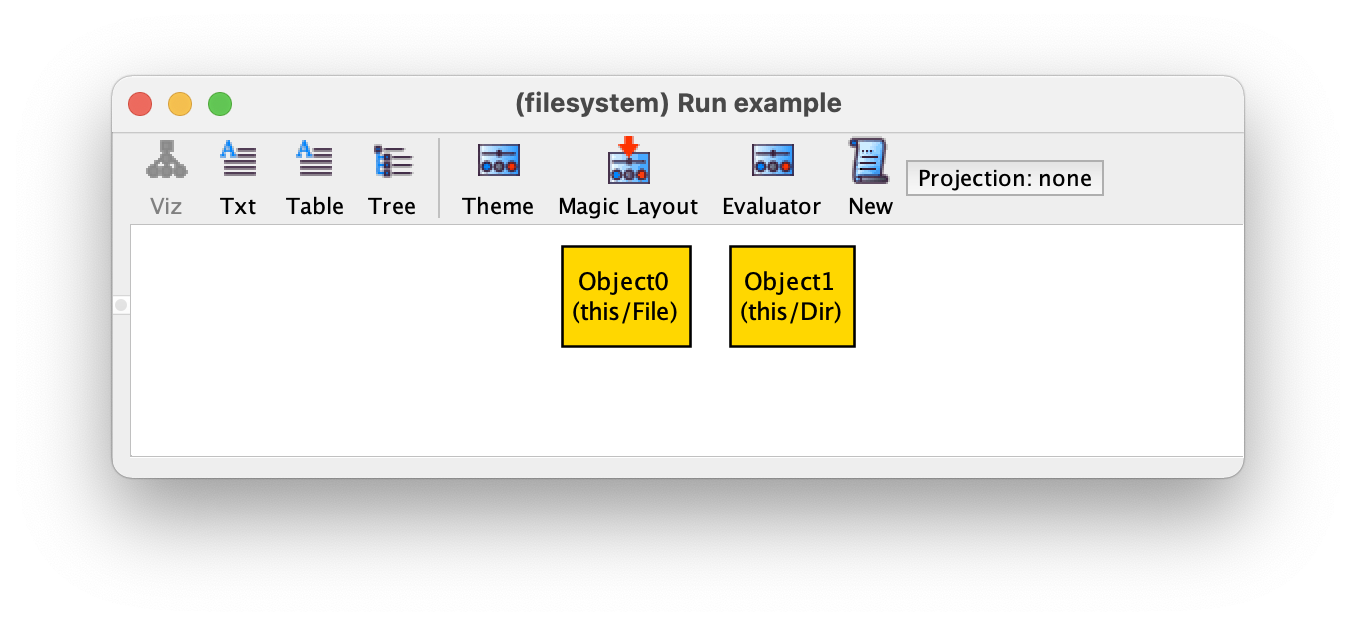
Here we have two objects, one of them is a directory and the other a file. If we press New in the visualizer toolbar we could get the following instance.
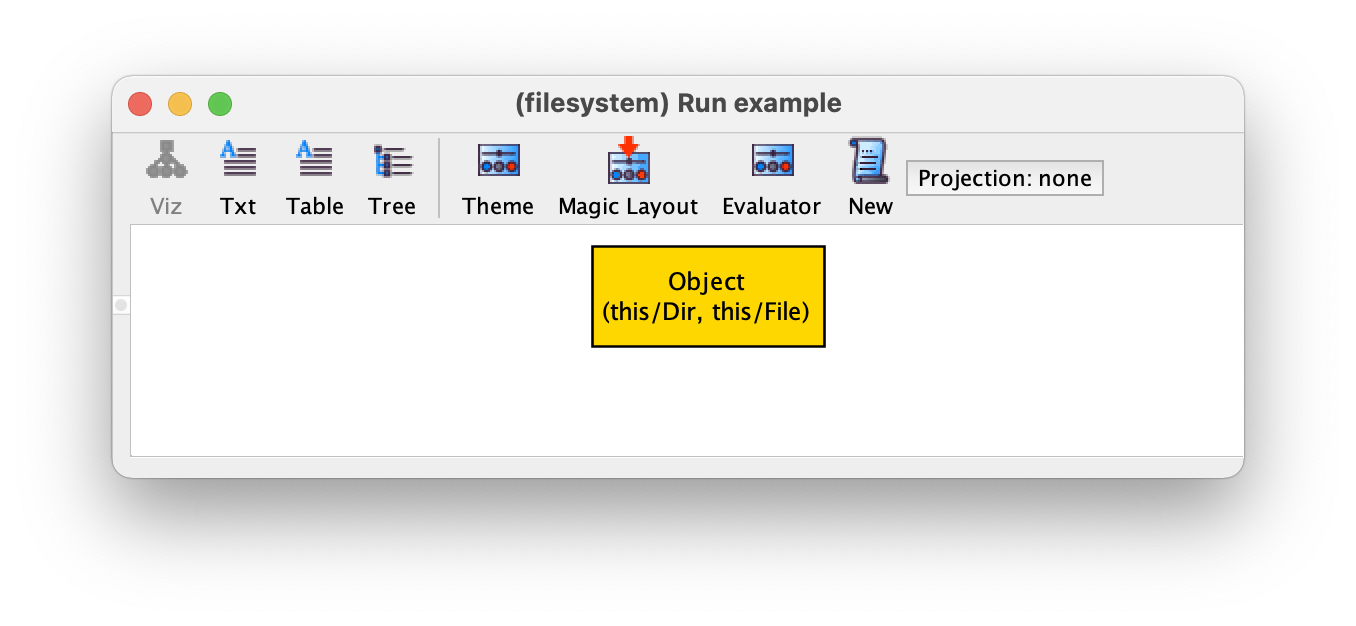
Note
Why am I not getting these instances?!
The Analyzer relies on lower level SAT solvers to perform the analysis. Depending on the Analyzer version and the solver you have selected to perform the analysis, you might get instances in a different order than this. You can choose the underlying solver in the Options menu. However, irrespective of the selected solver, if you keep pressing New you will obtain all the possible (non-symmetric) instances of a specification, so you are guaranteed to obtain these. Recall that two instances are considered symmetric (or isomorphic) if they only differ in the naming of the atoms that inhabit signatures.
In this instance we have a single object that is, simultaneously, a
directory and a file. Obviously this is not something we wanted, but
of course it is allowed since both File and Dir are
arbitrary subsets of Object. To disallow this we can add a
constraint that forbids an object to be both a file and a directory,
by specifying that File and Dir are disjoint sets. To
impose this constraint in our specification we can specify it inside a
fact, as follows.
fact { no File & Dir }
Recall that & denotes set intersection and no
checks for set emptiness.
If we re-execute the example command, and iterate through our
instances using New we will no longer see objects that
are both files and directories, but we will eventually get an instance
such as the following, where we have the problem of having an object (Object0)
that is neither a file nor a directory.
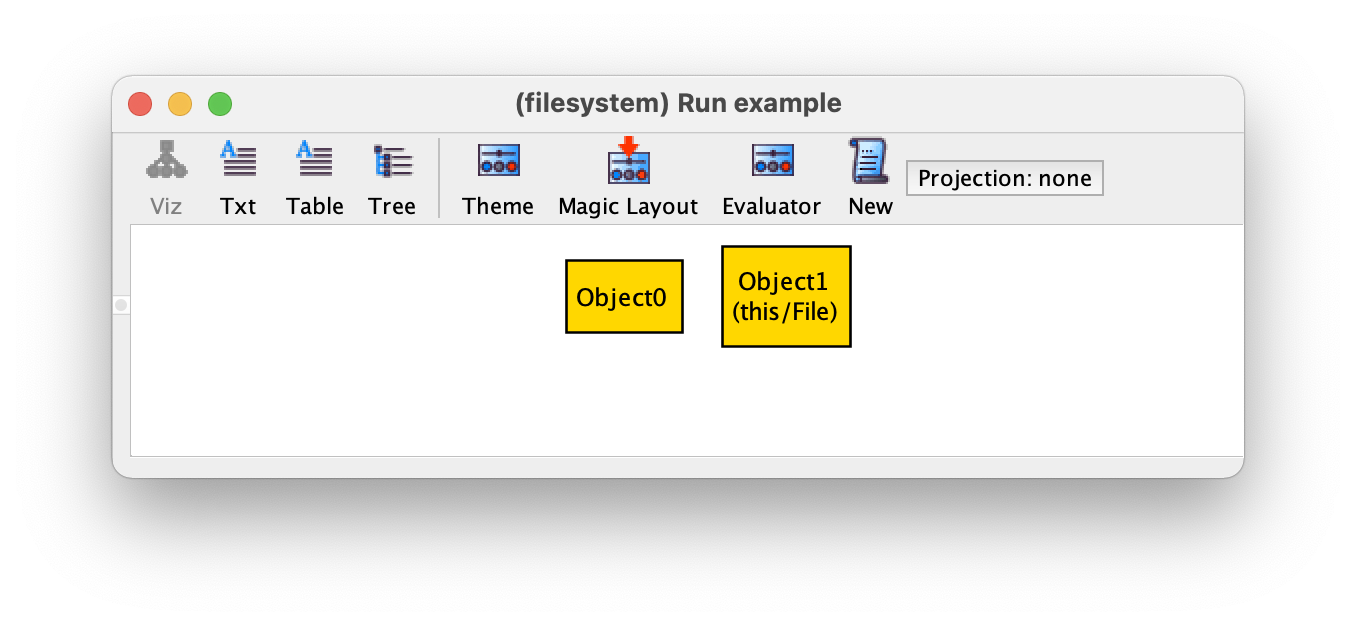
To solve this issue, we can add another constraint to our fact to
require that Object contains only atoms in File or
Dir, by requiring that Object is the union of both
(recall that + denotes set union and that constraints in
different lines inside a fact are implicitly conjoined).
fact {
no File & Dir
Object = File + Dir
}
By re-executing the example command and iterating through
instances we can now confirm that the previous issues appear to be solved.
It is very common to require that some subset signatures are
disjoint. Alloy has a special syntax to declare those: instead of
in, the keyword extends should be used in the signature
declaration. For example, to introduce File and Dir as
two disjoint subsets of Object we should declare them as
follows.
sig File extends Object {}
sig Dir extends Object {}
The first constraint in our fact is now redundant and can be
removed. Actually, we can try to check that indeed it is redundant by
issuing the following check command that should yield no
counter-example. Recall that a check command verifies that, up
to the specified scope, the formula declared between braces is
implied by the declared facts. If that is not the case we will get a
counter-example instance, one where the facts hold but the formula to
be checked doesn’t.
check { no File & Dir }
When executing this command we actually get a warning: the Analyzer
refuses to execute the command and tells us that the &
operator is irrelevant because the two sub-expressions that it is
trying to intersect are disjoint. This is a warning issued by Alloy’s
type system and is one of the advantages of using extends to
declare disjoint subset signatures, instead of relying on in
and additional facts. The main goal of the type system of Alloy is to
find so-called irrelevant expressions, essentially expressions that
the Analyzer is sure to always denote an empty set and are thus most
likely specification errors made by the user. If the user indeed wants
to write an expression that always denotes an empty set the special
constant none should be used instead, making that intention
explicit. More information about Alloy’s type system can be found in [FSE04].
Another advantage of using extends is that in the visualizer
atoms will be named according to the most specific signature they
belong to, which simplifies the understanding of instances. For
example, a possible instance returned by the example command
is the following, where it is now more clear that we have two files
and one directory.

Another frequent requirement for extension signatures is that they
form a partition of the parent signature. This is the case of
signature Object, that is partitioned in two sets,
File and Dir, and contains no atoms besides those
already contained in its extensions. Again, instead of adding facts to
ensure this, as we did with the constraint Object = File +
Dir, it is possible to declare a signature as abstract, by
preceding its declaration with the keyword abstract. Our
specification of the file system objects can thus be just as follows,
without any need for additional facts.
abstract sig Object {}
sig File extends Object {}
sig Dir extends Object {}
Now we would like to add a special object to denote
the directory that is the root of the file system. In Alloy it is not
possible in a specification to refer (and name) directly atoms
that inhabit signatures. There is however a trick to do so. Signature
declarations can be preceded by a multiplicity constraint that
restricts the cardinality of that signature. There are three
multiplicities that can be used in a signature declaration:
some forces the signature to always have some atoms;
lone restricts the signature to have at most one atom; and
one restricts the signature to have exactly one atom. To have
a specific atom for the root directory, we can thus declare with multiplicity one a
signature Root that extends
Dir.
one sig Root extends Dir {}
Root will always be a singleton set that contains the atom
that will be the root directory of the file system. Since it is
declared with extends, that atom will also be named
Root in the instance visualiser. A possible instance returned
by the example command is the following, where we have three
directories, one of them being (necessarily) the root directory.
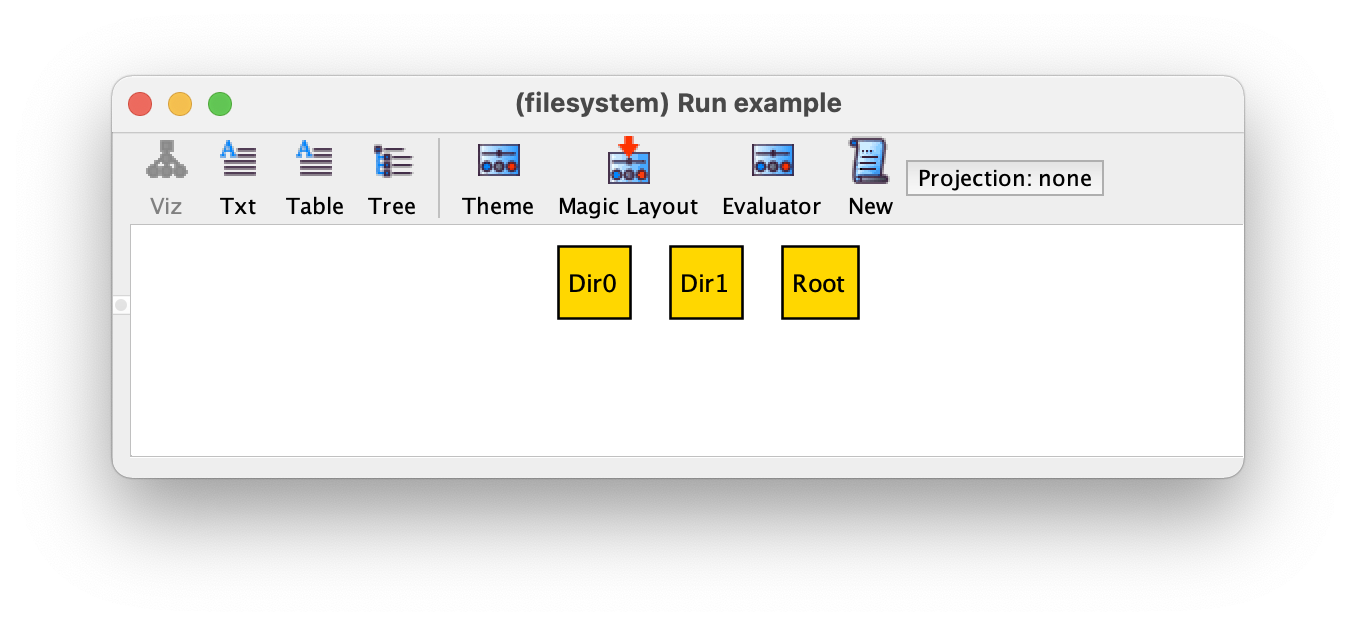
Tip
Enumeration signatures.
In Alloy it is very common to use extension signatures of
multiplicity one in the declaration of signatures that
behave like enumerated data types. For example, the following
specification declares a Color signature that contains
exactly three colours: Red, Green, and Blue.
abstract sig Color {}
one sig Red, Green, Blue extends Color {}
Here we see another feature of the Alloy language: if two or more signatures share the same features (multiplicity, parent signature, etc) they can all be defined together in the same declaration.
This pattern for declaring signatures that essentially correspond
to enumerated data types is so common, that Alloy has a keyword
enum for that purpose. Using this keyword, the
Color signature could be declared as follows.
enum Color { Red, Green, Blue }
However, there is a subtle difference between declaring enumeration signatures with keyword enum and with the normal sig keyword with multiplicity one: the former additionally imposes a total order between the respective atoms, corresponding to the order in which they are declared inside the braces. Later we will see how total orders can be used in Alloy.
Objects inside directories have an associated name, so we will need a
signature to represent the latter. In our file system model we will
allow files to be (hard) linked, meaning that the same file can have
different names in different directories (or even inside the same
directory). As such, we will also introduce a signature Entry
that will later be used as a (kind of) record to pack together an
object inside a directory and the respective name.
sig Entry {}
sig Name {}
Note
Why not just use strings for names!?
The reader may wonder if Alloy has any predefined types, such as
integers or strings. If that is the case, why not just use strings
to represent names, instead
of declaring a new signature Name? Actually, Alloy does
have predefined types, namely Int for (bounded) integers
and String for strings. However, these types should be
avoided as much as possible, because their semantics is
substantially more tricky than that of normal signatures, and analysis can be
confusing and somehow crippled when using them (in particular with
strings). Actually, in many cases they just have too much semantics
for the intended use: for example, strings can be concatenated and
there is the notion of one string being a substring of another, but for
the file system specification none of this is of interest when specifying the abstract concept of
a name. The only thing we will need in this case is to check for
name equality, and normal signatures and atoms already provide us
that basic semantics. People also tend use integers when they
actually need something much more simple, semantics wise. For
example, we sometimes need to specify a signature where there is
some total order imposed and, in first sight, integers are very
convenient for that. However, integers have a more rich semantics
than just being a total order, and we can easily axiomatise a total
order on a signature with some simple facts and thus avoid the
analysis drawbacks that come with their usage (see Working with integers).
So, when should you use String or
Int? The former has very little use, and actually, even if
recognised by the Analyzer, is not even part of standard Alloy. The
latter is sometimes useful, for example when you do need to perform
arithmetic operations, such as additions or subtractions.
A possible instance of our specification so far is the following, with two different names, two entries, one file and two directories, one of which is the root.
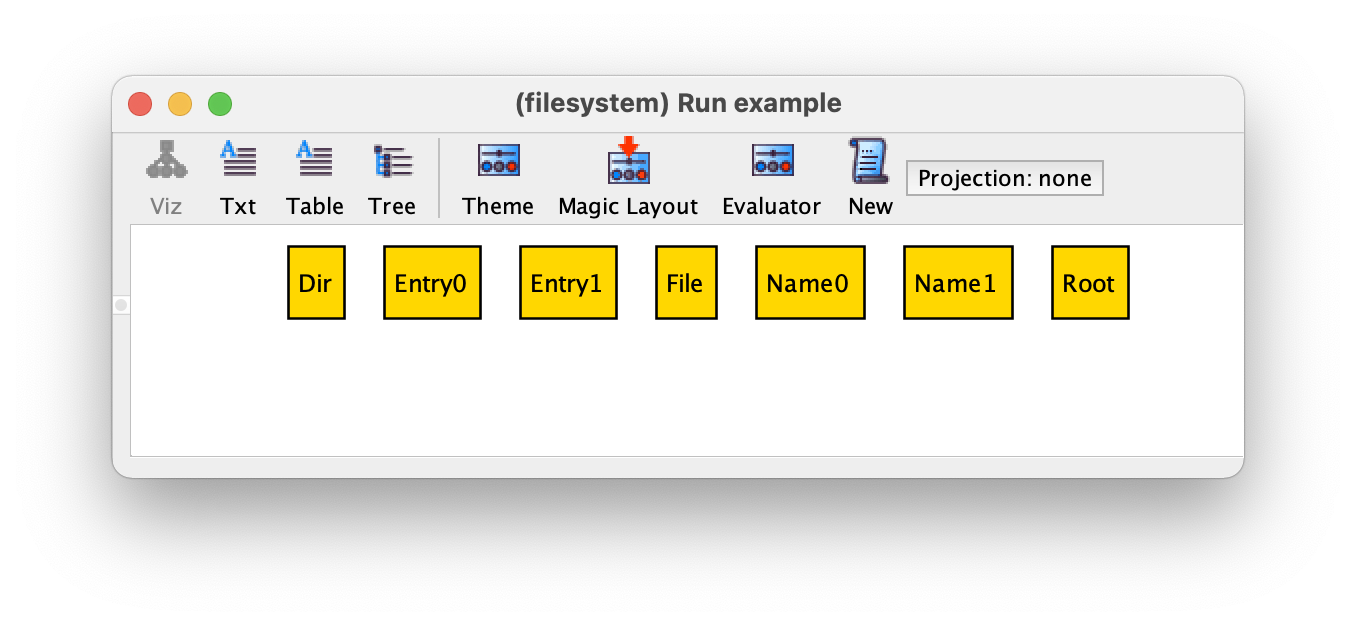
Recall that all analysis commands are executed with a (user definable)
scope for each signature, that sets the maximum number of atoms that
can inhabit it. By default, the scope is 3 for all top-level
signatures: in our example this means that instances will have at most
3 names, 3 entries, and 3 objects. With this scope, instances with,
for example, 3 files, will not be possible, because the root always
exists and consumes 1 of the 3 atoms that can inhabit
Object. To change the default global scope the keyword
for followed by the desired scope should be used. You can also
set a different scope for each top-level or extension signature (another difference
from declaring signatures with in), by
using the keyword but followed by a comma separated list with
different scopes for each signature. You can also set an exact scope
for a signature with the keyword exactly, meaning that that
signature will always be inhabited by the exact number of specified
atoms. For example, to execute the example command with a
default scope of 4, up to 2 entries, and exactly 3 names, the
scope should be set as follows.
run example {} for 4 but 2 Entry, exactly 3 Name
Note that in this case, the only top-level signature that will be
subject to the default scope of 4 is Object, since specific
scopes are given for the other two top-level
signatures. Multiplicities on signature declarations also affect the
scope: for example, a signature with multiplicity one will
always have scope of exactly 1, and an error will be thrown if you try to
set an incompatible scope. There is also some interaction between the
scope of extension signatures and the scope of the respective parent
signatures. In particular, if the scope of extension signatures
enforces a minimum number of atoms, the scope defined for the parent
signature will automatically grow to accommodate that minimum
number. For example, in the following command the scope of
Object will automatically grow to 4 since Object must
contain at least the root and three files.
run example {} for 3 but 2 Object, exactly 3 File
Field declaration
Having declared our signatures we now proceed with the declaration of
fields. Fields are declared inside the braces of a signature
declaration, and are essentially mathematical relations (sets of
tuples) that connect atoms of the enclosing signature to other atoms
(of the same or other signatures). In our example we will
need a relation that connects each directory with the respective set
of entries. This binary relation, which will be named entries,
is a set of ordered pairs, where the first atom of each pair is a
directory and the second atom is an entry. The type of the first atoms
in the tuples that form a relation dictates the signature in which it
must be declared as a field. In the case of entries, since it
relates atoms of signature Dir to atoms of signature
Entry, it must be declared as a field in the former
signature. To do so, we change the declaration of Dir as follows.
sig Dir extends Object {
entries : set Entry
}
As we can see, a field declaration consists of its name followed by a
colon and the target set, optionally preceded be a multiplicity
declaration. In this case the target set is signature Entry
and the multiplicity is set, meaning that one atom of
signature Dir can be related by entries to an
arbitrary number of atoms of signature Entry. The other
options for the multiplicity are the same that can be used in signature
declarations: one, lone, or some. If no
multiplicity is given, the default is one. In this book we
will avoid this implicit multiplicity in field declarations, and always
explicitly state the multiplicity of a field, even if it is
one.
By executing command
run example {}
we could now get the following instance.
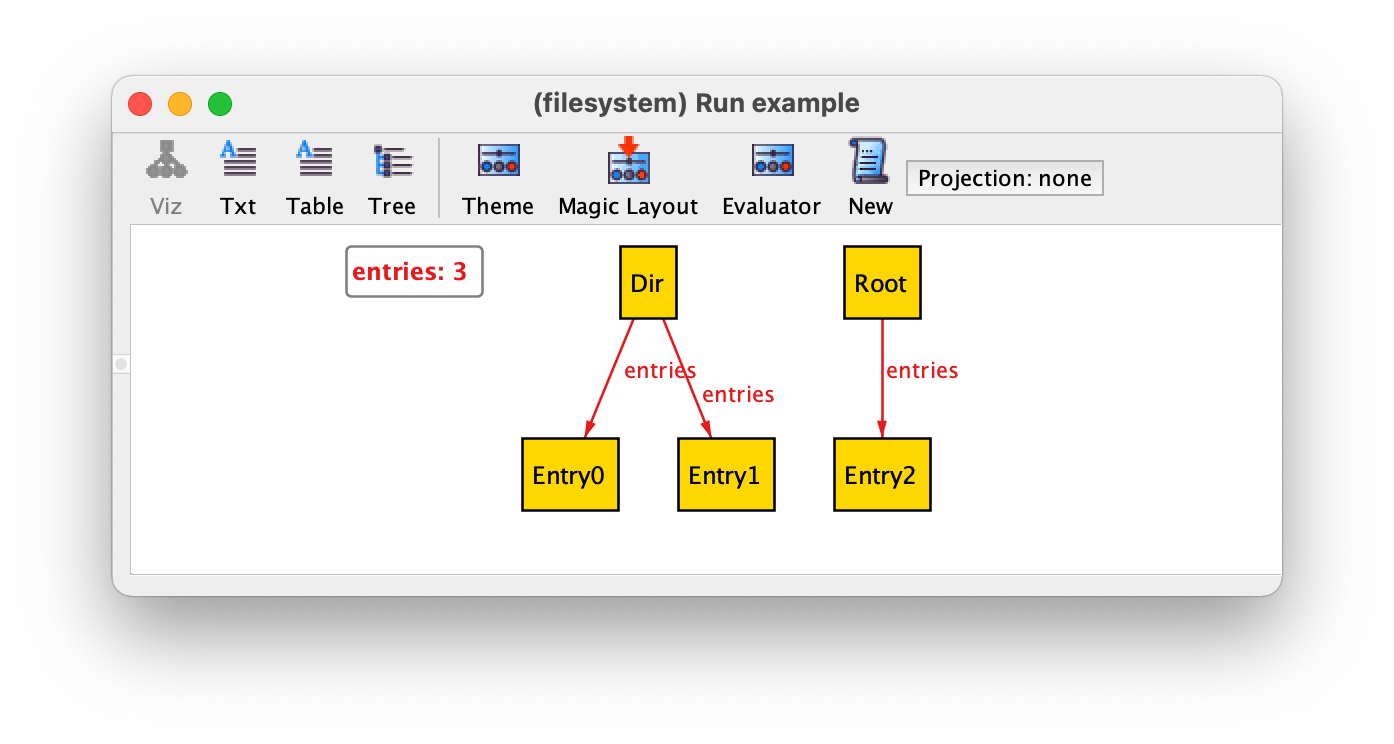
Binary relations are depicted by the Analyzer using labelled arrows: each
arrow is a pair contained in the relation, whose first atom is the
source of the arrow and whose second atom is the target. In this case,
relation entries is a set that contains three pairs:
(Dir,Entry0), (Dir,Entry1), and
(Root,Entry2). In this example we have a directory Dir
with two entries and the Root with one entry, but given the
set multiplicity constraint it would also possible to have
directories without any entries.
Note
Actually, everything is a relation!
In chapter An overview of Alloy we alerted the reader to the fact that
in Alloy every expression denotes a set. To be more precise, every
expression in Alloy denotes a relation - a set of tuples - hence
the Alloy motto: everything is a relation! In Alloy we can declare
relations of arbitrary arity: the arity is the size of the tuples
contained in it. Relation entries is a binary relation of
arity 2. Later we will see how to declare relations of higher
arity, for example ternary relations of arity 3. However,
signatures are in fact also relations of arity 1: they are sets of
tuples of size 1. For example, in the previous instance, signature
Dir contains the following unary tuples: (Dir) and
(Root). Do not to confuse the name of the atom
Dir with the signature name Dir: the former is just
an automatically-generated name for one of the two inhabitants of the latter! When we start using
relational logic operators to write constraints, it will be more
clear why the fact that everything denotes a relation considerably simplifies the syntax and
semantics of the language.
Tip
The evaluator.
The Alloy instance visualiser has an evaluator that can be used to
compute the value of any expression. To access this evaluator just
press the Evaluator button in the toolbar of the instance
visualiser window. Every expression denotes a relation. The
visualiser depicts the values of the signatures and fields of an
instance as labelled graphs. Another way to depict the value of a
relation (of any arity) is as a table where each line is one of the
tuples contained in it. This is the default way the evaluator will
show the values of relational expressions. To ask for the value of an
expression just type it in the evaluator and press
Enter. For example, here is the result of asking in the
evaluator what is the value of relations Dir and
entries.
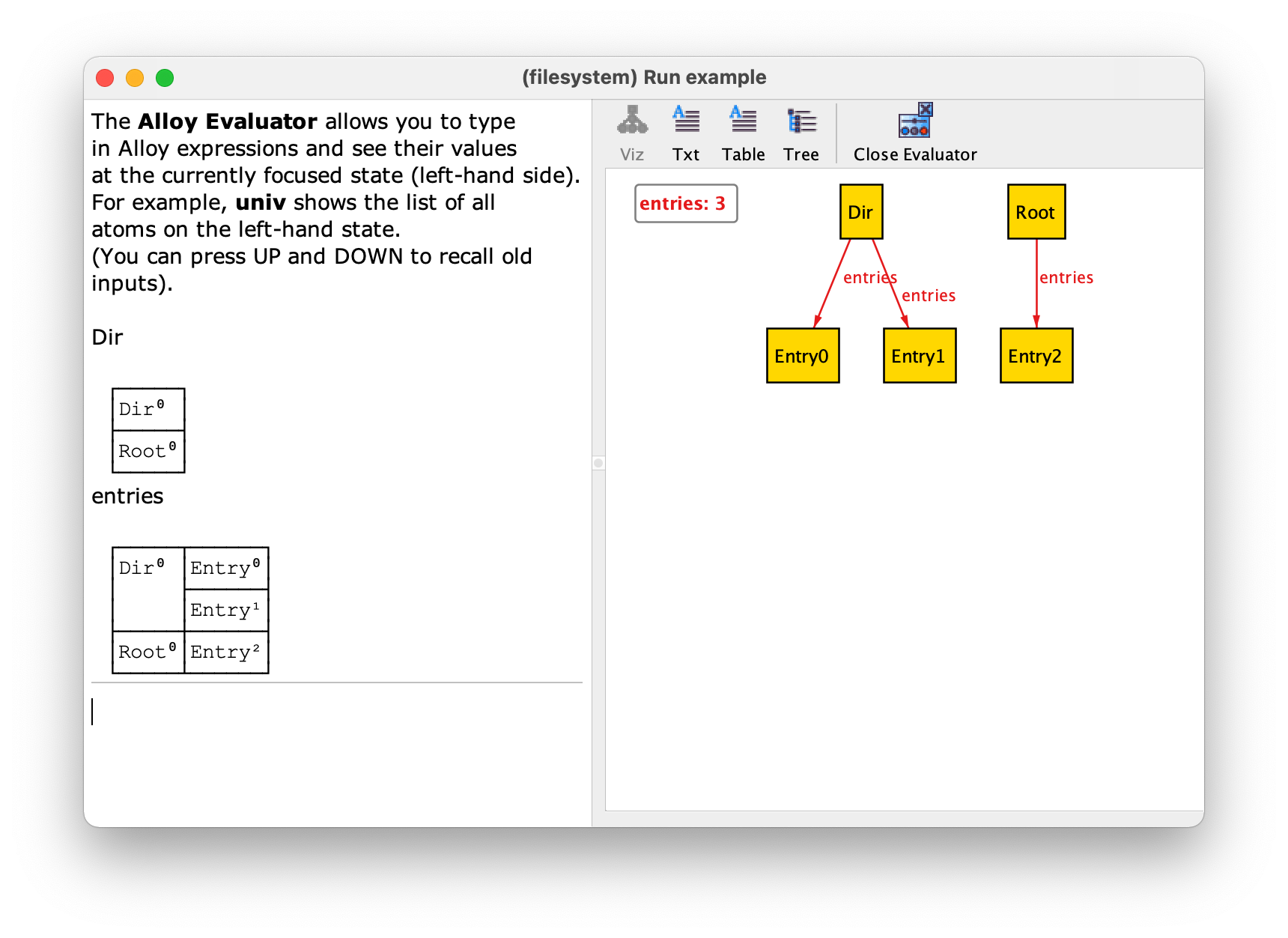
The evaluator is sometimes very useful to debug your constraints: besides asking for values of relational expressions you can also ask for the values of formulas, so it is a very convenient way, for example, to know what sub-formulas of a constraint are true or not in a particular instance. To close the evaluator and return to the normal instance visualizer just press the Close Evaluator button in the toolbar. Section Using the evaluator to debug specifications presents the evaluator in more detail.
Besides entries we will declare two more fields in our
specification: the first, that we will call name, relates each entry
in a directory with the respective name; the second, that we will call
object, relates each entry in a directory with the respective
file system object (either a file or a directory). Both these
relations should be declared inside signature Entry and both will
have multiplicity one, since exactly one target atom is
associated with each entry. Because of this, an entry acts like a record that packs together an object inside a directory and the respective name. In section Using higher-arity relations we will see how this association (between directories, their contents, and the respective names) can alternatively be modelled by a ternary relation.
sig Entry {
name : one Name,
object : one Object
}
Let’s change our run command to ask directly for a more
complex instance of our specification, namely one with a larger global
scope of 4, and necessarily containing some files and some directories
besides the root (recall that - is the set difference
operator, and that keyword some, besides being used as a
multiplicity constraint in declarations, can be used in formulas to
check if a set (or relation) is non-empty).
run example {
some File
some Dir - Root
} for 4
Executing this command could yield the following instance.
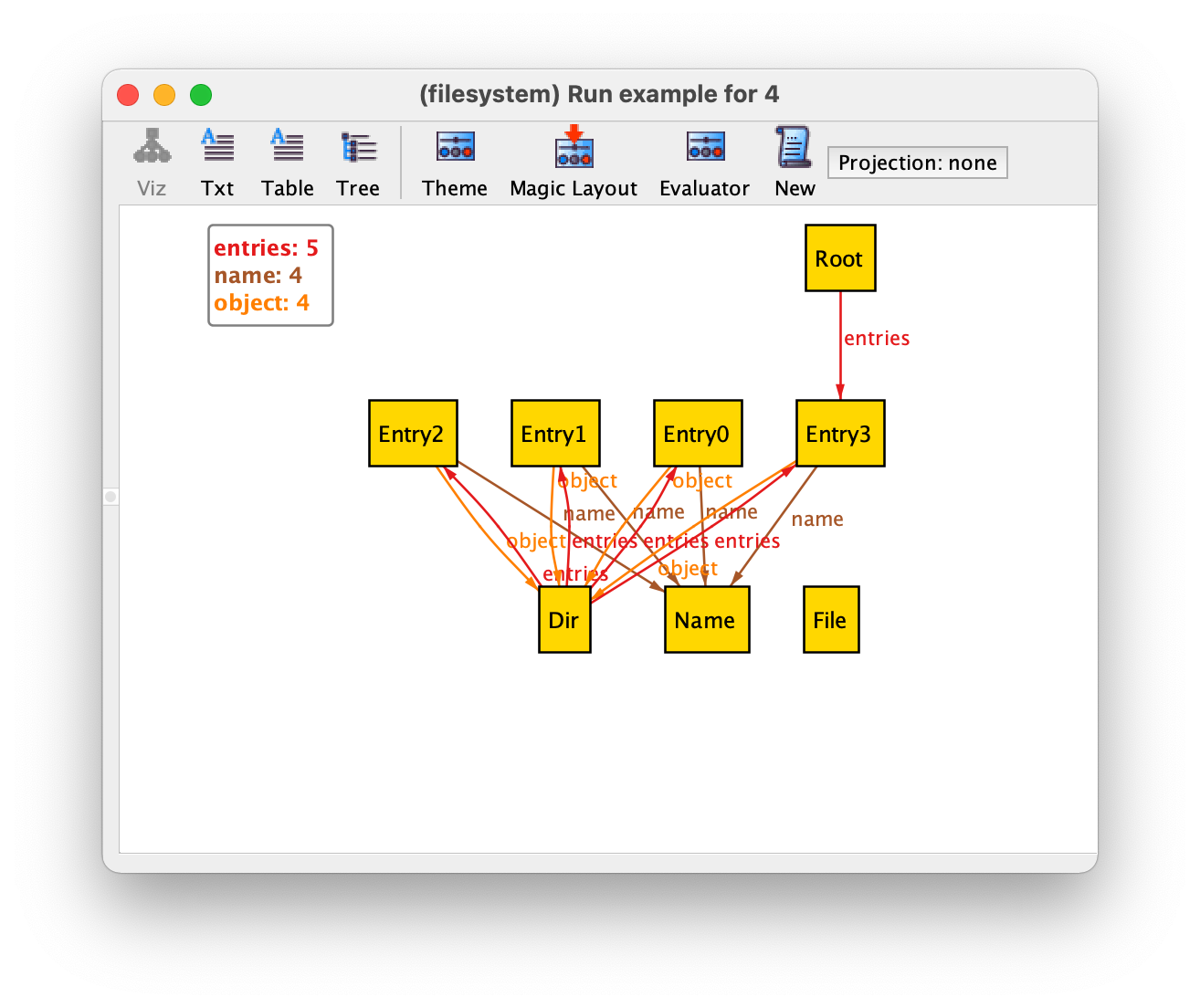
Here we can immediately see some problems with our specification, for example entries shared between directories or files not belonging to any directory. As our specification grows, instances become increasingly difficult to understand, and so, before adding facts to our specification to solve these issues, we will first see how the theme can be customised to simplify the visualisation of instances.
Theme customisation
To open the theme customisation menu, press the button Theme in
the toolbar of instance visualiser window. The first customisation we
will apply is to show the names of directory entries as attributes in
the respective atoms, instead of using arrows pointing to the
name. This will unclutter substantially the depiction and is a very
common customisation for fields of multiplicity one, in
particular for fields that somehow act as identifiers, as is the case
of name. To do so, first select the field name, and
then tick the Show as attribute option in the top
pane. This option will show the name of an entry as an attribute but
still keep the respective arrows. To remove them, tick twice
Show as arcs to choose the Off option. Your
theme options for relation name should look as follows.
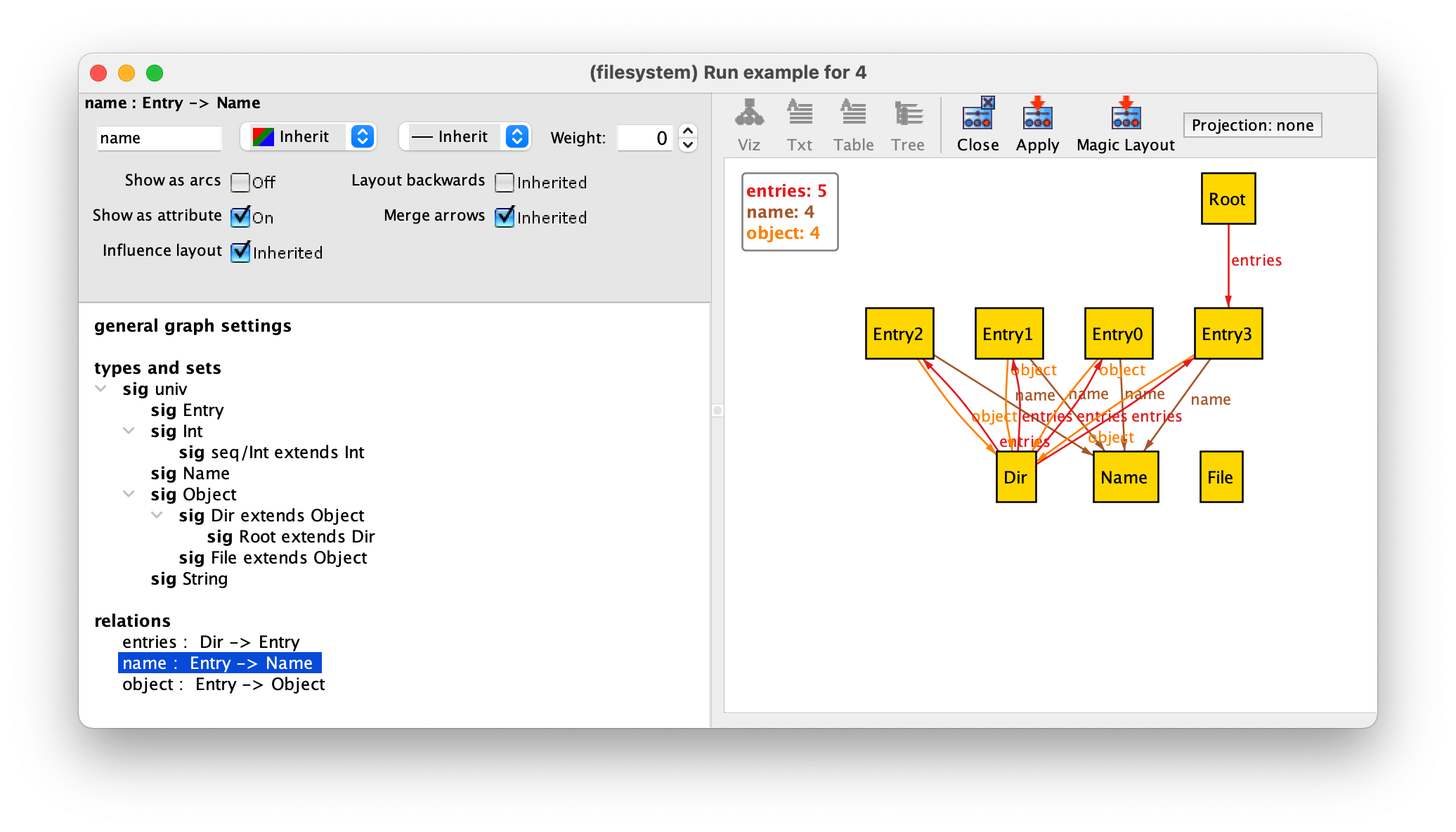
By pressing Apply in the toolbar and then Close the instance will now be depicted as follows.
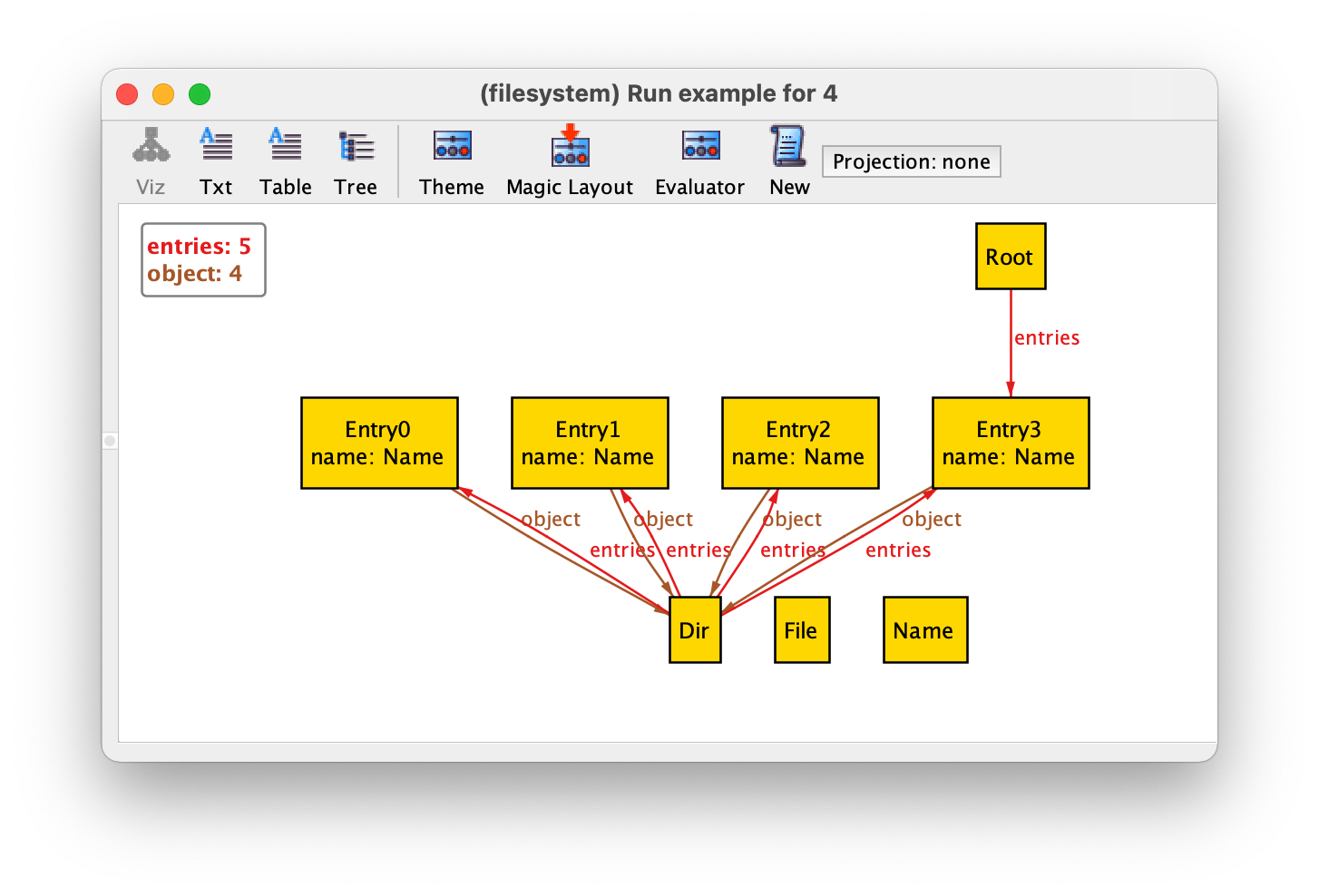
We now have some unconnected Name atoms. Since names were only
used in directory entries, where they are now shown as attribute, we
can remove them from the graph. To do so, select Theme
again (actually when changing many options it is better to keep the
theme customisation menu open and just keep pressing Apply
without closing it to see the effect), select the Name signature,
and then tick the Show option twice to choose the
Off option. After pressing Apply the
Name atom will disappear.
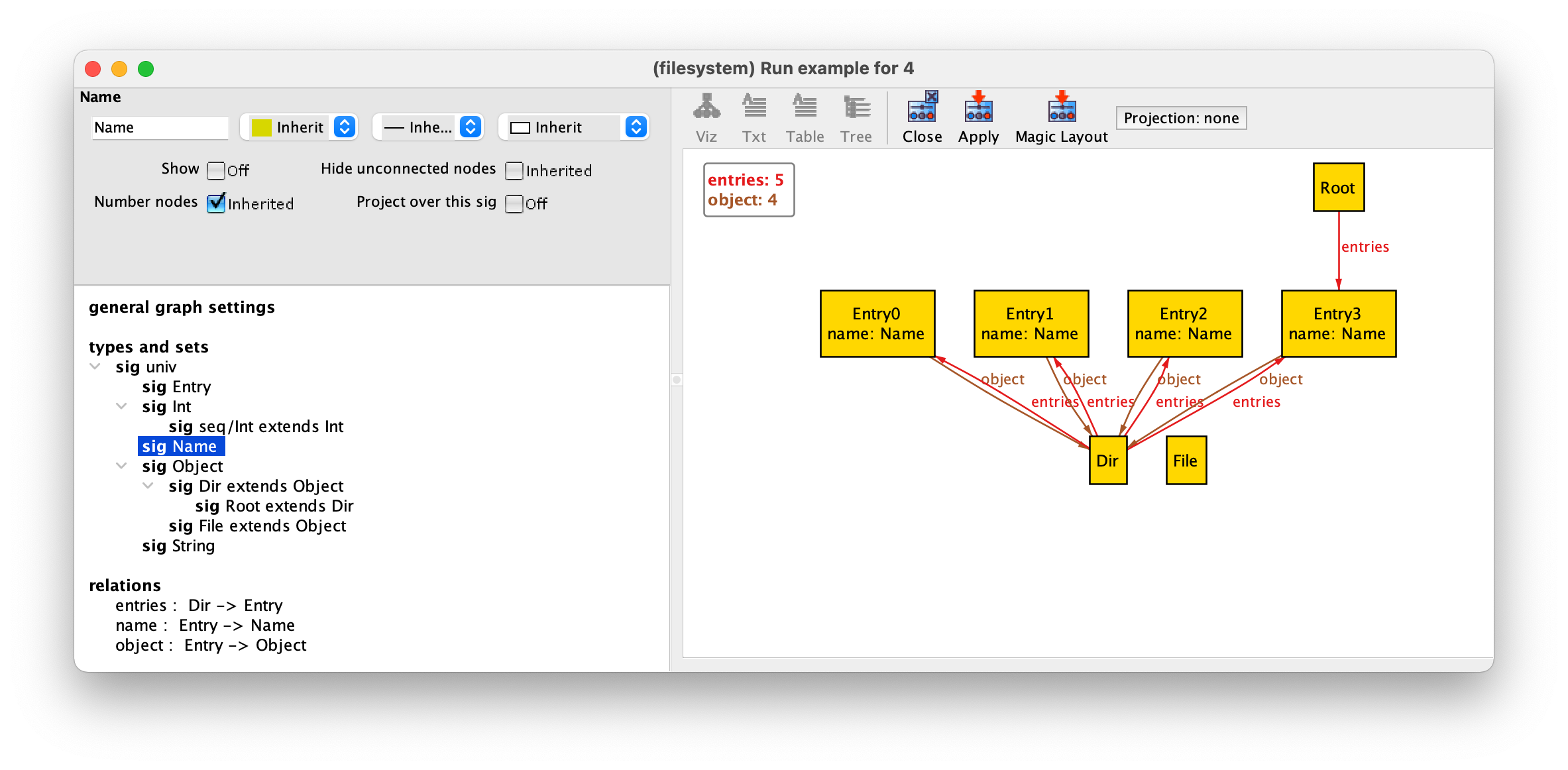
Another common customisation is to give different colours (or different shapes) to atoms belonging to different signatures. First, we will select a different colour palette, with more subdue colours. First select the general graph settings, and select the Martha (for Martha Stewart) palette both for node and edge colours. After pressing Apply we will get some nice faded colours.

Since entries are auxiliary structures in defining the (supposedly)
tree-like structure of the file system, we will paint them grey. To do
so select signature Entry, then the colour Gray in
the drop-down menu in the top left-hand corner, and finally Apply.
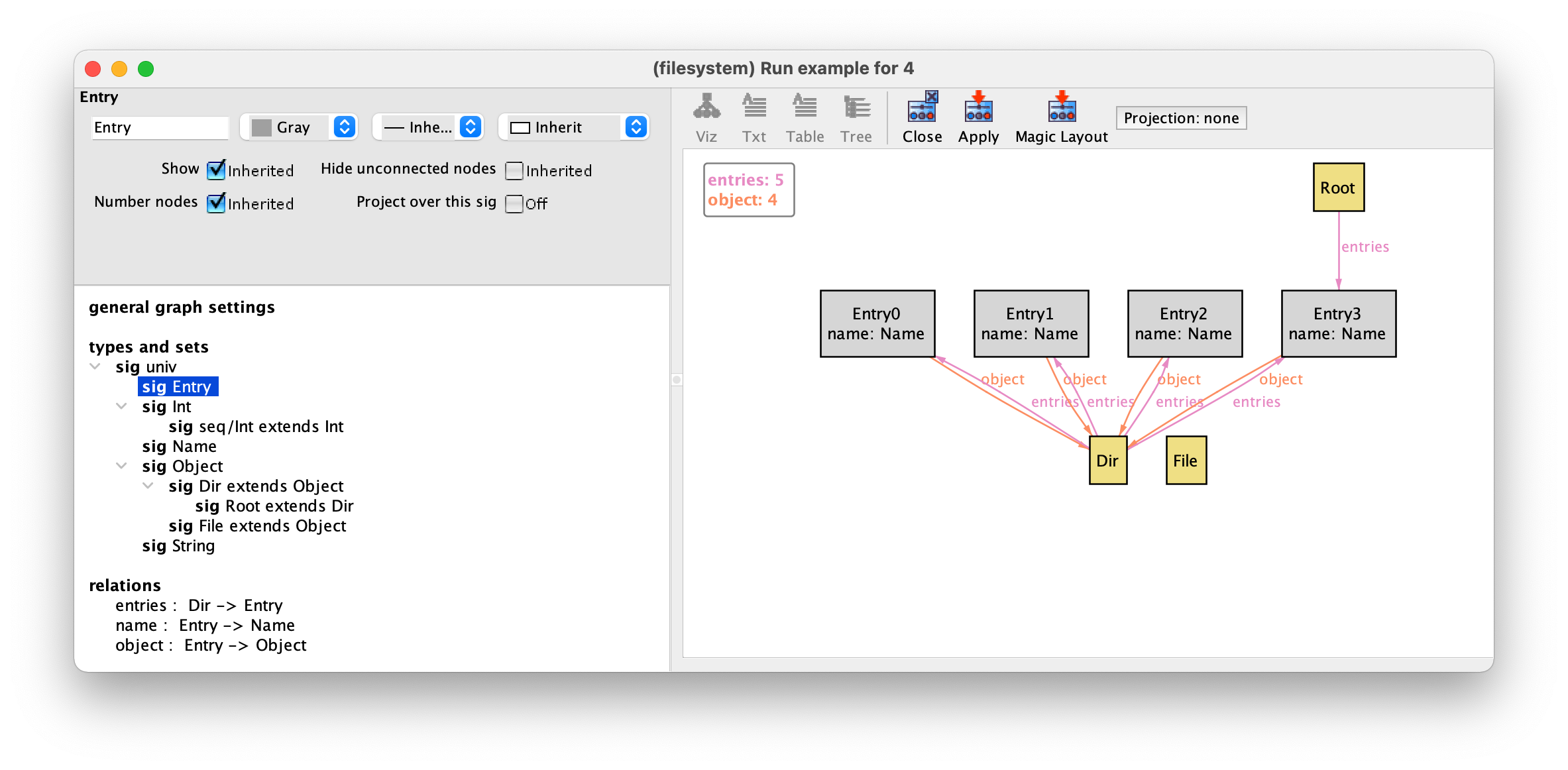
For file system objects we will choose a more eye-catching red
colour. We don’t have to set this colour separately for Dir and
File. By default most theme options of extension signatures
are set as inherited from their parent signature. As such, it suffices
to set the colour red for the Object signature, and both their
children will inherit this setting. Finally we will choose different
shapes for different file system objects. Let’s keep files as
rectangles, but choose the shape Trapezoid for directories
and a House for the root. The shape can be chosen in the
drop-down menu in the top right-hand corner. After pressing Apply we have the following visualization.
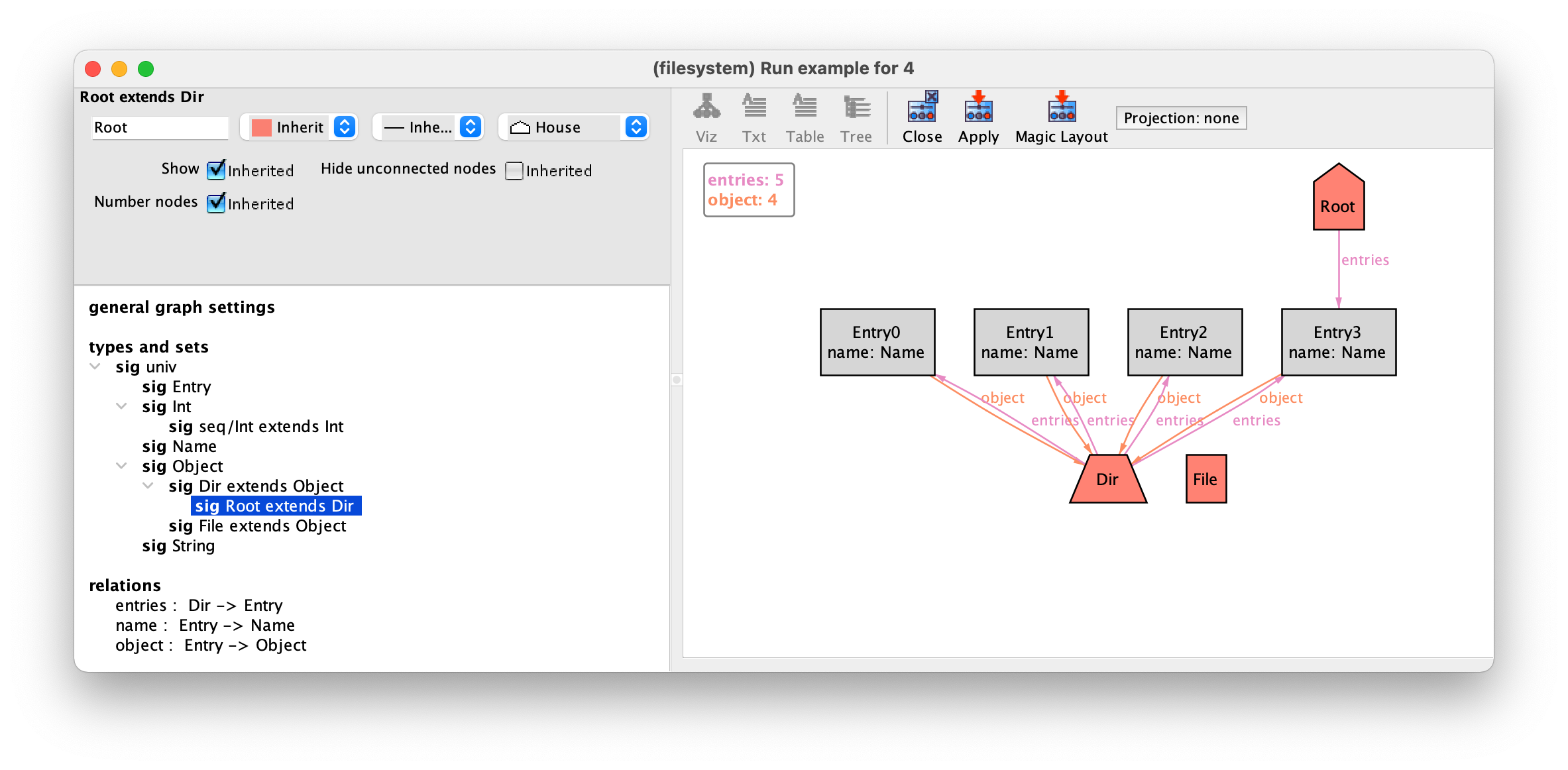
For the moment these are all the customisations we will use, and so we can close the theme customisation menu. Notice that you can always reset your theme settings by going to the menu option . You can also save your theme for later use in the option .
Instead of customising manually your theme, you can also try out the Magic Layout button in the toolbar of the instance visualiser. This will “magically” choose options for visualising the different elements of your specification: sometimes the results are good enough and it will save you some work. The result of magic layout for our instance is the following.
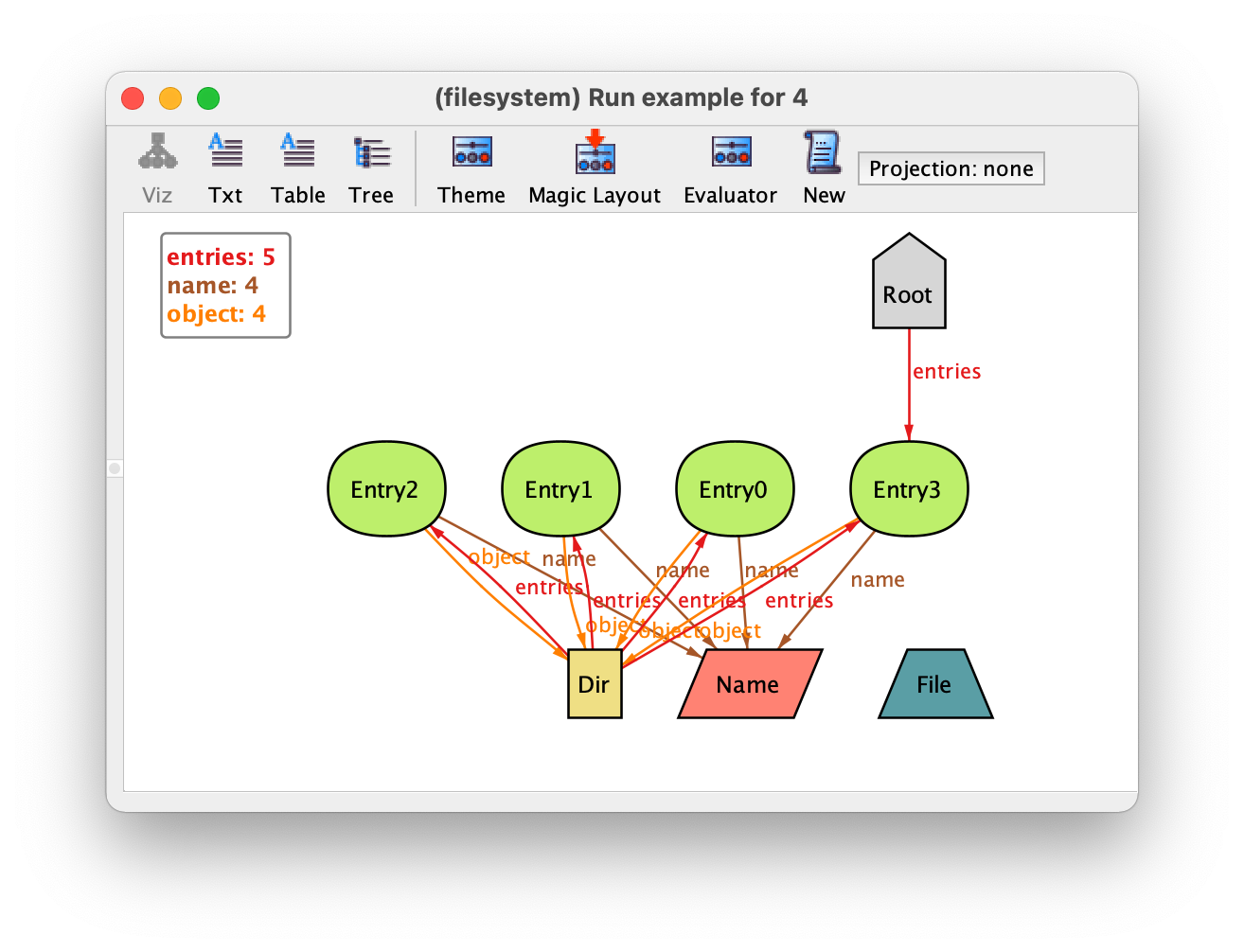
More information about how the magic layout actually works can be found in [LED07]. In this case we prefer our handmade customisation and so we will load back our previously saved theme by selecting .
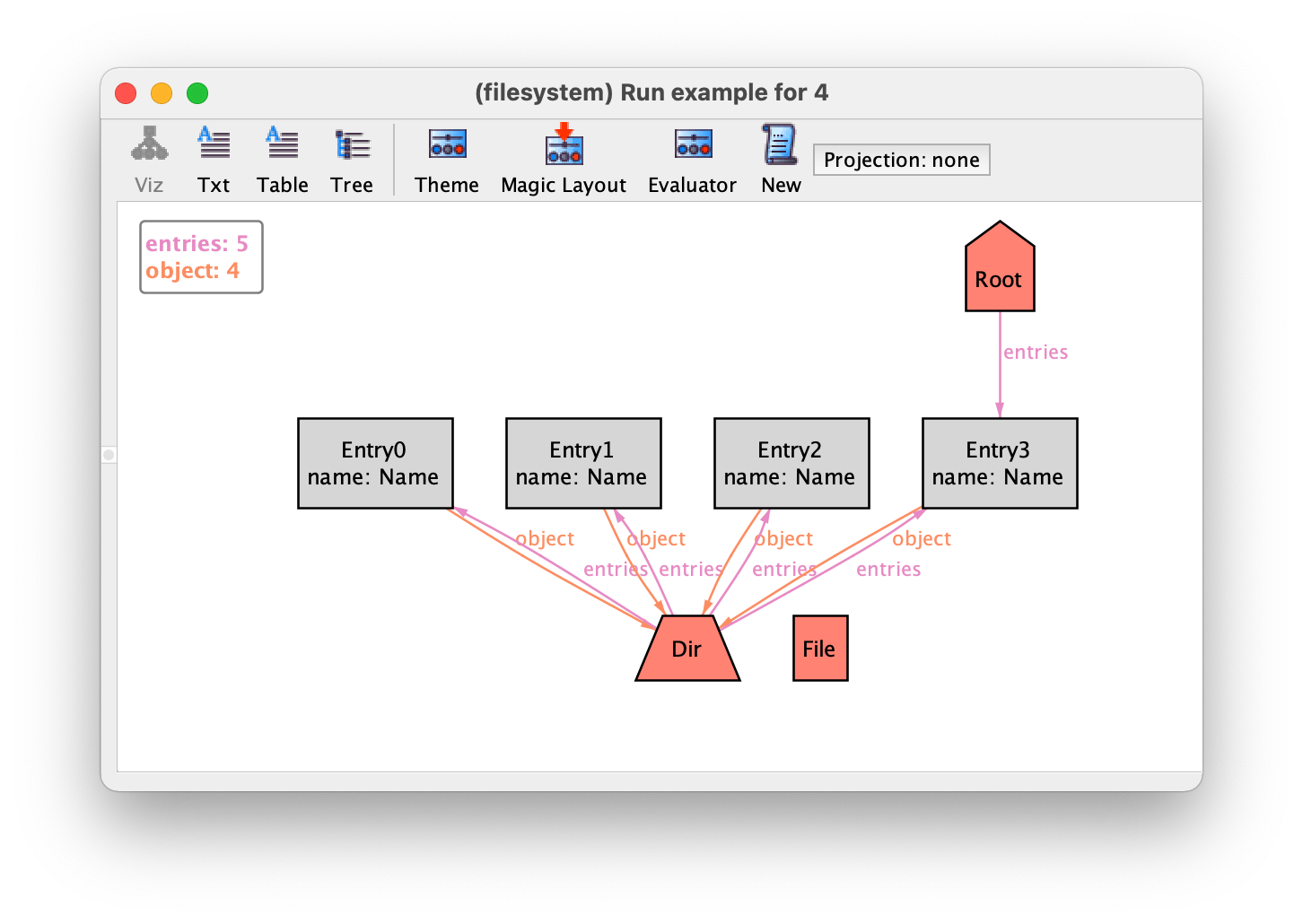
Property specification
By inspecting the above instance we can easily detect several problems in our specification, namely:
Shared entries between directories (entry
Entry3belongs both toDirandRoot).Different entries in the same directory with the same name (all entries inside
Dirhave the same nameName).The same directory appears in more than one entry (
Diris the object of all entries).A file that does not belong to an entry (
File)
We should write facts to prevent these issues. In
Alloy, formulas in facts are written in a variant of first-order logic called
relational logic. Relational logic extends first-order logic with so
called relational operators, that can be used to combine (or
compose) relations (which in first-order logic are known as
predicates) to obtain more complex relations. We have already seen
some of these operators, namely the classic set operators such as
intersection (&), union (+), and difference
(-). Notice that every relation (of any arity) is a set of tuples, so
these can be applied to any relation. Let’s suppose, for example, we
have two binary relations, mother and father, that
relate a person with the respective mother and father. Then the
relation that gives the parents of a person can be obtained by taking
the union of both, namely mother+father.
The essential operator in relational logic is composition, the
binary operator written as . (a dot). This operator allows us to
navigate through the declared fields to obtain related atoms. Understanding
how this operator works is key to be proficient in Alloy. Here, we
will explain its informal semantics by means of several examples: the
detailed semantics and more examples will be given in chapter
A relational logic primer. In particular we will focus on the simplest,
and most frequent, use of this operator, namely when applied to a
set and a binary relation. For example, suppose e is a singleton set containing an Entry and d a
singleton set containing a Dir. These could be, for example,
parameters of a predicate or instantiated as result of a
quantifier. To obtain the name of an entry you can compose it with
relation name: relational expression e.name denotes
the name of e. Since name is a field
with multiplicity one, the result of this composition is
necessarily a singleton set. Similarly, e.object is the
singleton set with the file system object that is contained in entry
e.
The notation is, on purpose, similar to that of accessing an attribute
of an object in an object-oriented programming language, as the effect
is essentially the same when dealing with singleton sets. However, we
can also apply it to relations with multiplicity different than
one and arbitrary sets. For example, d.entries
retrieves the set of all entries in directory d. This set can
be empty or contain an arbitrary number of entries, since relation
entries has multiplicity set. A more interesting usage
is when composing a non-singleton set with a relation. For example,
Entry.name is the set of all names of all entries and
Dir.entries is the set of all entries that belong to some
directory. Also, you are not forced to compose a set followed by a
relation: the other way around also works. Relations can be navigated
forwards, from the source signature to the target signature, but also
backwards from the target signature to the source one. For example,
entries.e denotes the set of directories that contain entry
e: this set can be empty, if e is not contained in any
directory, or even have more than one directory, since when declaring
a field there are no multiplicity restrictions imposed on the source
signature. We can also compose with an arbitrary set on the right-hand
side: for example, entries.Entry is the set of all directories
that contain some entry.
Compositions can be chained to obtain atoms that are somehow
indirectly related. For example, d.entries.object denotes the
set of all file system objects that are contained in the entries of
directory d. And again, it is possible to navigate backwards
through composition chains. For example, entries.object.d
denotes the set of all directories with entries that contain directory
d.
Having understood how . works, we can now declare a fact that prevents the first
issue identified above. We can almost directly transliterate the
natural language requirement to relational logic. Given any two
different directories x and y, the property that there
should be no common entries between both can be specified as no
(x.entries & y.entries): first we determine the intersection of the two
sets of entries of both directories, and then we check that this set
is empty using the keyword no. To complete our first property
specification we just need to universally quantify over all different
directories x and y (recall that all denotes
the universal quantification of first-order logic).
fact {
// Entries cannot be shared between directories
all x, y : Dir | x != y implies no (x.entries & y.entries)
}
The need to quantify over two ore more different variables is very
common, so Alloy provides the modifier disj, that can be added
between the quantifier and the variables, precisely to restrict those
variables to be different. This modifier simplifies the formulas,
since we no longer need the implication to indirectly restrict the
range of the quantification. Using this modifier, our property can be
restated as follows.
fact {
// Entries cannot be shared between directories
all disj x, y : Dir | no (x.entries & y.entries)
}
As expected there are many different ways to specify the same
property. In the case of this property, a simpler formula can be obtained by navigating
backwards in the entries relation, and specifying instead that
for every entry e there should be at most one directory in the
set entries.e, the set of all directories that contain
e as an entry. This alternative formulation would look as
follows. Recall that lone can be used to check if a set
contains at most one atom.
fact {
// Entries cannot be shared between directories
all e : Entry | lone entries.e
}
Alloy has a special formula syntax to directly restrict the
multiplicities of both end points of a binary relation. For example,
to state that a relation r relates every atom of source
signature A to at most one atom of target signature B,
and every atom of B to at least one atom of A, we
could write the formula r in A some -> lone B. Not stating a
multiplicity next to an end point is the same as having multiplicity
set. With this special syntax, we could have yet another
alternative formulation of our first constraint.
fact {
// Entries cannot be shared between directories
entries in Dir lone -> Entry
}
Note
A bestiary of binary relations.
The constraint entries in Dir lone -> Entry forces relation
entries to be injective, one where no two atoms of the
source signature point to the same target atoms. This is one of the
four basic properties of relations we can obtain by varying the
multiplicities of the source and target signatures. If we had
entries in Dir some -> Entry we would have a surjective
relation, one where every atom of the target is related to some
source atom. If entries in Dir -> lone Entry relation
entries would be simple (or a partial-function), a
relation where every source atom is related to at most one
target. And if entries in Dir -> some Entry relation
entries would be entire (or total), since every source atom is
related to at least one target. By combining these four properties
we get additional well-known relation types. A relation that is
both entire and simple is a function: every atom of the source is
related to exactly one target. A representation is a relation
that is both entire and injective, and dually, an abstraction is
a relation that is both simple and surjective. An injection is a
function that is also a representation, and a surjection is a
function that is also an abstraction. Finally, by combining all
four basic properties we get a bijection: a one-to-one mapping
between the source and the target signatures. The following table
summarises these properties.
injective |
entire |
simple |
surjective |
||
|
|
|
|
||
representation |
function |
abstraction |
|||
|
|
|
|||
injection |
surjection |
||||
|
|
||||
bijection |
|||||
|
|||||
To enforce that different entries in the same directory have different names we could write the following fact.
fact {
// Different entries in the same directory must have different names
all d : Dir, disj x, y : d.entries | x.name != y.name
}
Here you can see another nice feature of Alloy’s syntax: it is
possible to quantify over any expression and not only over
signatures. In this case, x and y will be instantiated
with all the (distinct) atoms belonging to d.entries, the set
of entries of each directory d. An alternative formulation of
this property is the following.
fact {
// Different entries in the same directory must have different names
all d : Dir, n : Name | lone (d.entries & name.n)
}
Expression d.entries & name.n denotes the set of entries in
directory d that also have name n. This set must
contain at most one entry for every directory d and name
n.
To prevent the third issue we can enforce that each directory is contained in at most one entry as follows.
fact {
// A directory cannot be contained in more than one entry
all d : Dir | lone object.d
}
Note that it would be wrong to specify this property as object in Entry lone -> Dir, since this would force relation object to only relate entries to directories (excluding files).
The last issue is a an example of a broader problem: there is nothing in our specification that forces all objects except the root to belong to an entry. To specify such a constraint, we can begin by determining the set of all objects that are
contained in any entry using expression Entry.object, and
then enforce that this set is equal the set of all objects
minus the root.
fact {
// Every object except the root is contained somewhere
Entry.object = Object - Root
}
After adding these four facts, if we re-execute the example
command and iterate with New we could get the following instance.
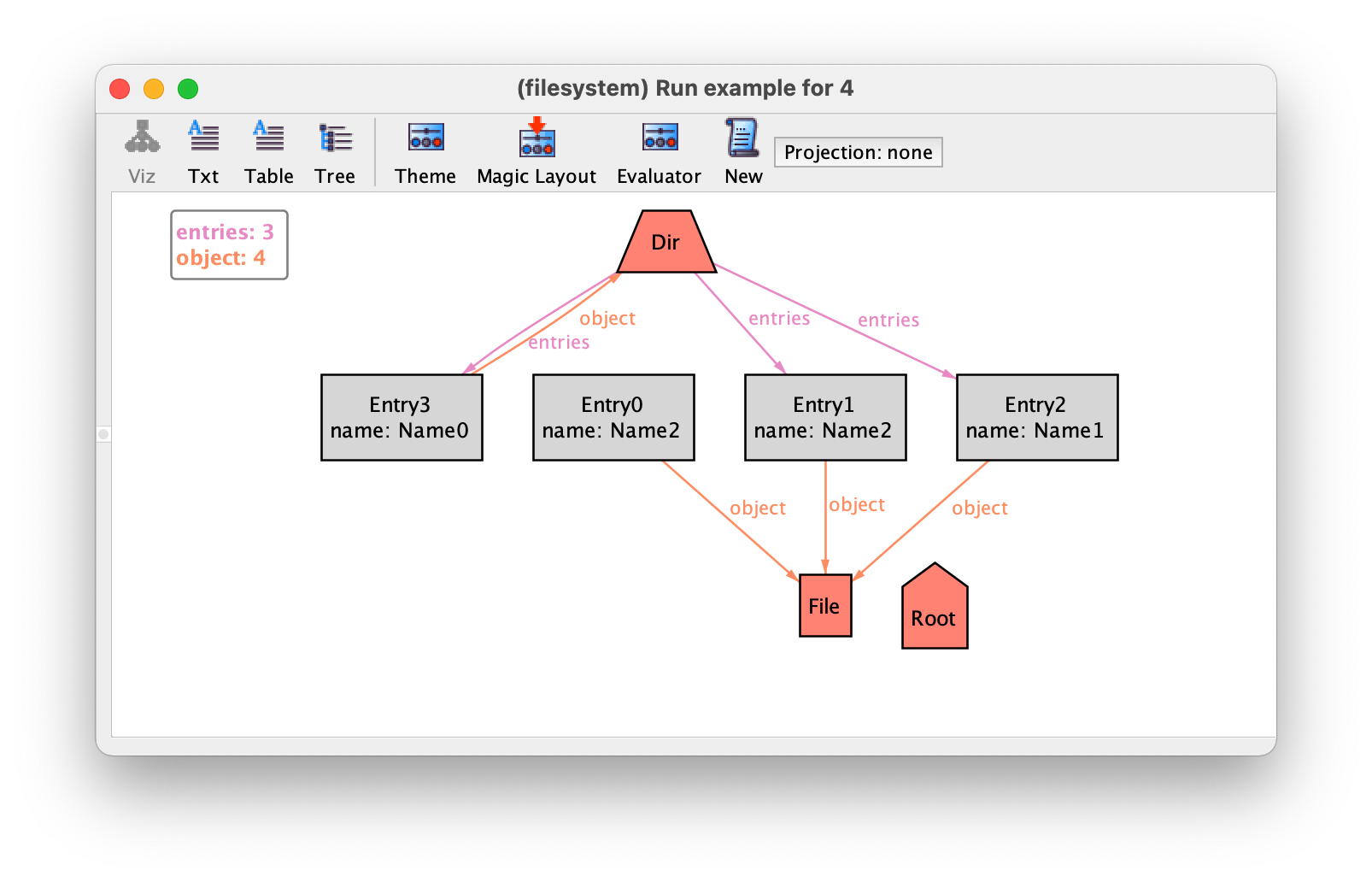
The problems identified above are now gone, but we still have two issues (the second already present in the previous instance):
Entries not belonging to any directory.
Directories contained in themselves.
To address the first issue we could just strengthen the first fact introduced above to demand that every entry belongs to one and exactly one directory.
fact {
// Entries must belong to exactly one a directory
entries in Dir one -> Entry
}
Concerning the second issue, to forbid directories from
containing themselves as entries, we can use the previously described
expression d.entries.object to determine the objects
contained in a directory d. Then we just need to forbid
d itself from being a member of this set.
fact {
// Directories cannot contain themselves
all d : Dir | d not in d.entries.object
}
Re-executing again command example and iterating a couple of
times with New reveals no more issues. Obviously, it is
impossible to manually inspect all possible instances, so we will
proceed with the verification of our desired assertion, namely that
the file system contains no partitions.
Assertion verification
To specify this assertion we need to determine the set of all objects
that are reachable from the root. We have already seen how to
determine the set of objects that are directly contained in a
directory. Namely, Root.entries.object is the set of objects
directly contained in the Root directory. The set of objects
reachable from Root contains not only these, but also the
objects that they contain, which can be determined as
Root.entries.object.entries.object
Of course, we also need to include the objects contained in these, and so on, and so on. Essentially, we would like to determine the following set:
Root.entries.object +
Root.entries.object.entries.object +
Root.entries.object.entries.object.entries.object +
...
The problem is how to fill in the ... in this expression:
ultimately the number of times we need to compose
entries.object depends on the size of our file system, and we
would like our specification to be independent of this
value. Fortunately, relational logic includes a so-called transitive
closure operator (^) that when applied to a binary relation
(or relational expression) determines the binary relation that results
from taking the union of all its possible compositions. Essentially,
given a relation r, ^r is the same as r + r.r +
r.r.r + .... Seeing our instances as labelled graphs, the expression
x.^r will determine the set of all atoms that can be reached
from atom x by navigating in one or more steps via arrows
labelled with r. Transitive closure is the reason why
relational logic is strictly more expressive than first-order logic:
our desired assertion could not be expressed in first-order logic
alone.
By using transitive closure applied to relational expression
entries.object we can determine the set of all objects
reachable from root. To ensure that there are no partitions, this set
must contain all objects (except the root itself). Our desired
assertion can thus be specified as follows.
assert no_partitions {
// Every object is reachable from the root
Object - Root = Root.^(entries.object)
}
To verify that this assertion is a consequence of all the facts that
have been imposed before, we can define a check command.
check no_partitions
Unfortunately, executing this command reveals a counter-example.
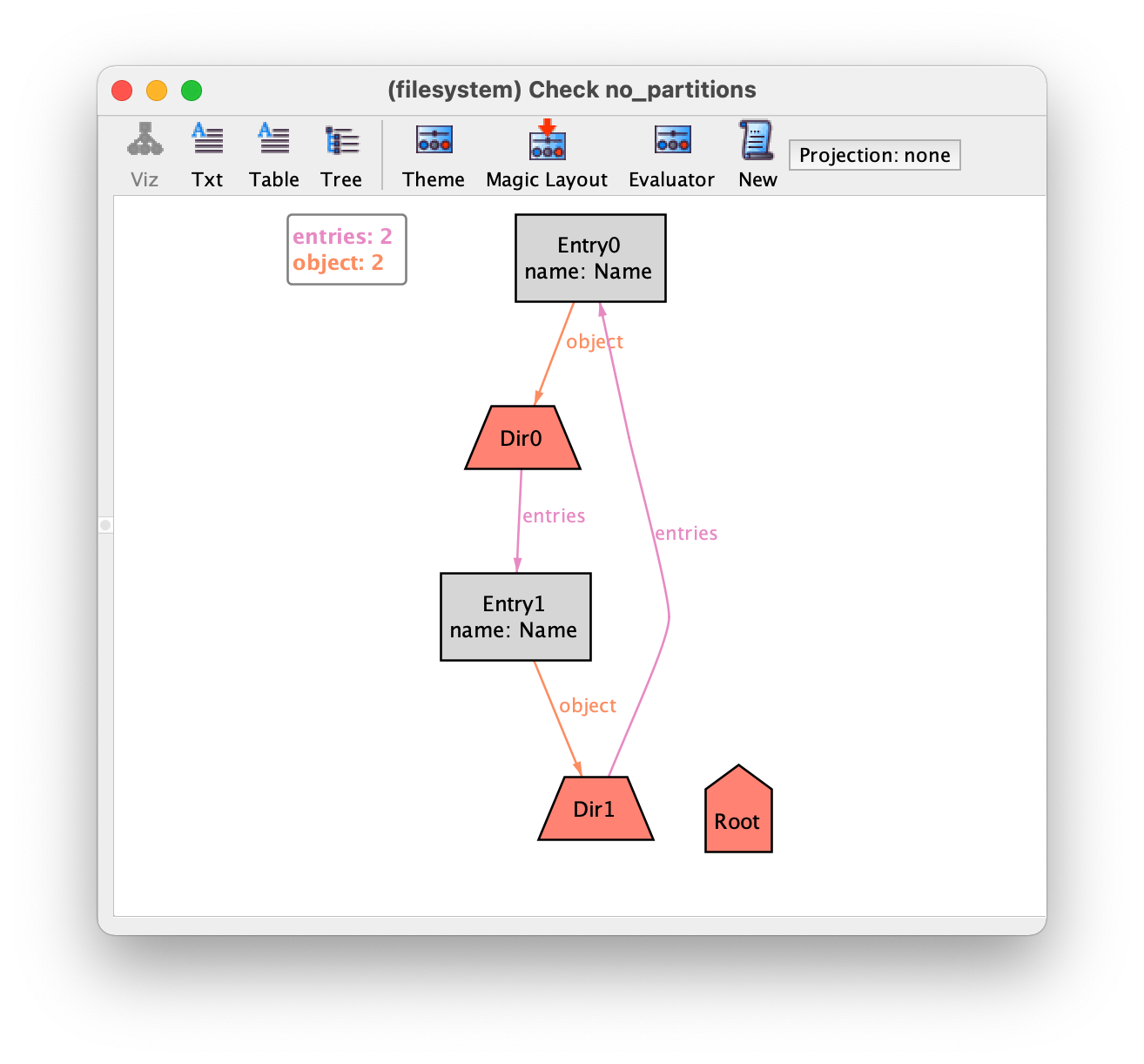
The problem is that we have two directories that contain each
other. Fortunately, this counter-example is not an issue in real file
systems, but exposes a problem in our specification. One of the facts
specified above imposed that no directory can contain itself, but this
alone is not sufficient: a directory cannot contain itself directly, nor
indirectly. To fix that fact, we can again use the transitive closure
operator to determine the set of all objects reachable from any
directory d, and then disallow d from being a member
of this set.
fact {
// Directories cannot contain themselves directly or indirectly
all d : Dir | d not in d.^(entries.object)
}
Re-executing the check command no longer yields
counter-examples. Although with the bounded analysis performed by the
Analyzer we can never be entirely sure that the assertion is valid, we
can set a higher scope to increase our confidence that that is indeed
the case.
check no_partitions for 6
Tip
Be sure your specification is still consistent!
You should always be wary of the results of checking your
assertions, in particular when they yield no
counter-examples. Recall that a check command checks that
an assertion is implied by the conjunction of all declared
facts. If your facts are inconsistent, in the sense that their
conjunction is false, or admit only very trivial instances (for
example empty ones), your assertion can be trivially true. For
example, in this example we changed one of the facts before our
final check that yielded no counter-examples. We should have
checked that this change did not accidentally make our
specification inconsistent. To do so we could execute a run
command after the final check, and iterate a bit through the
returned instances to make sure the specification is still
consistent and admits non-trivial file systems. Of course, just
pressing New is not the ideal method to check if
expected file system examples are still possible. In section
Defining test scenarios with formulas we will see how to define run commands
that behave like unit tests that directly search for specific
instances of a specification.
So far we used only a reduced subset of all relational logic
operators that are part of Alloy’s syntax. We did use the two most
important ones, composition (.) and transitive closure
(^), and with these alone (plus the standard set theory
operators) it is possible to write most facts and assertions of
interest. For a complete list of relational logic operators please see
the A relational logic primer chapter.
Using higher-arity relations
Caution
This chapter is still under construction
abstract sig Object {}
sig File extends Object {}
sig Dir extends Object {
contents : Name -> Object
}
one sig Root extends Dir {}
sig Name {}
fact {
// Different entries in the same directory must have different names
all d : Dir, n : Name | lone n.(d.contents)
}
fact {
// A directory cannot be contained in more than one directory
all o : Dir | lone contents.o
}
fact {
// Directories cannot contain themselves directly or indirectly
all d : Dir | d not in d.^{ d : Dir, o : Object | some d.contents.o }
}
fact {
// Every object except the root is contained somewhere
Name.(Object.contents) = Object - Root
}
Exercises
To practice relational logic, access the following Alloy4Fun models and specify all the listed constraints. Each constraint is specified in a separate predicate, and for each there is a command that can be used to check its correctness. If the constraint is not correctly specified a counter-example will be shown. The counter-example will include an atom that clarifies if it is an example that the incorrect constraint is currently rejecting but should be accepted or one that is currently being accepted but should be rejected.
Specify the Git Object Model using Alloy. Focus on the connection between the different kinds of objects and ignore details like authors or committers. Start with a version that abstracts away the hashes that identify the objects and connect them directly instead. In a second version add the explicit hashes and the constraints that characterize them. Try to customize the visualizer theme to simplify to comprehension of instances. In particular, in the second version with explicit hashes, try to define auxiliary relations that can be used in the visualizer to depict the connections between the objects.
Specify Red-Black Trees using Alloy. To specify the constraint that “every path from a given node to any of its descendant NIL nodes goes through the same number of black nodes” you can use the cardinality operator (
#), but be careful with the scope ofInt(the scope sets the desired bit-width). Try to customize the visualizer theme to simplify to comprehension of instances.